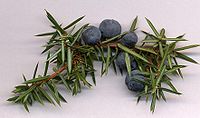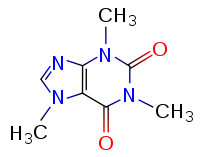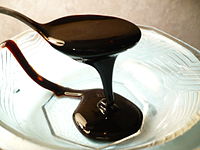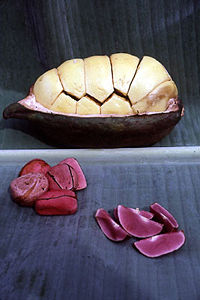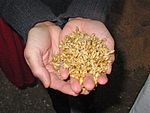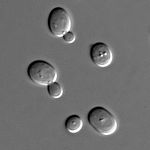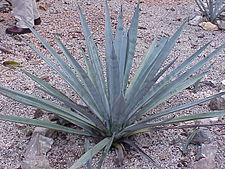- Portal:Drink/Selected ingredient
-
These are the articles that are featured on the Drink Portal main page.
If you wish to add an article, you will be expected to make a good-faith effort to address objections that are raised. Consensus must be reached for an article to be promoted to be given selected article status. When adding a qualifying article, it must be classified as a Good article or better. These articles can be found in the Category:A-Class Food and drink articles, Category:FA-Class Food and drink articles and Category:GA-Class Food and drink articles categories. Please note that you cannot determine the status of an article that you have worked on.
Please follow the usage instructions listed below when placing a new article here,
Selected content:
- Selected article ←
- Selected pictures
- Selected people
- Selected recipes
- Selected quotes
- Selected ingredients
Selected content tools:
- What is a featured article?
- What is a featured list?
- What is a featured picture?
- What is a featured topic?
- What is a good article?
Usage
The template for used to configure these sub-pages is located at {{Selected ingredient}}
- Add a new Selected article to the next available subpage.
- Update "max=" to new total for its {{Random portal component}} on the main page.
Selected ingredient 1
Hops are the female flower cones, also known as strobiles, of the hop plant (Humulus lupulus). They are used primarily as a flavoring and stability agent in beer, though hops are also used for various purposes in other beverages and herbal medicine. The first documented use in beer is from the eleventh century. Hops are used extensively in brewing today for their many purported benefits, including balancing the sweetness of the malt with bitterness, contributing a variety of desirable flavors and aromas, and having an antibiotic effect that favors the activity of brewer's yeast over less desirable microorganisms. The hop plant is a vigorous climbing herbaceous perennial, usually grown up strings in a field called a hopfield, hop garden or hop yard when grown commercially. Many different varieties of hops are grown by farmers all around the world, with different types being used for particular styles of beer.
Portal:Drink/Selected ingredient/1Selected ingredient 2
A juniper berry is the female seed cone produced by the various species of junipers. It is not a true berry but a cone with unusually fleshy and merged scales, which give it a berry-like appearance. The cones from a handful of species, especially Juniperus communis, are used as a spice, particularly in European cuisine, and also give gin its distinguishing flavour. According to one FAO document, juniper berries are the only spice derived from conifers, though tar and inner bark (used as a sweetener by Apache cuisines) from pine trees is sometimes considered a spice as well.
Portal:Drink/Selected ingredient/2Gin was developed in the 17th century in the Netherlands. It was first intended as a medication; juniper berries are a diuretic and were also thought to be an appetite stimulant and a remedy for rheumatism and arthritis. The name gin itself is derived from either the French genièvre or the Dutch jenever, which both mean "juniper". Other juniper-flavored beverages include the Finnish rye-and-juniper beer known as sahti, which is flavored with both juniper berries and branches.
Selected ingredient 3
Caffeine is a bitter white crystalline xanthine that acts as a psychoactive stimulant drug and a mild diuretic (speeds up urine production) in humans and other animals. Caffeine was discovered by a German chemist, Friedlieb Ferdinand Runge, in 1819. He coined the term "kaffein", a chemical compound in coffee, which in English became caffeine. Caffeine is also called guaranine when found in guarana, mateine when found in mate, and theine when found in tea; all of these names are synonyms for the same chemical compound.
Portal:Drink/Selected ingredient/3Caffeine is found in varying quantities in the beans, leaves, and fruit of some plants, where it acts as a natural pesticide that paralyzes and kills certain insects feeding on the plants. It is most commonly consumed by humans in infusions extracted from the cherries of the coffee plant and the leaves of the tea bush, as well as from various foods and drinks containing products derived from the kola nut. Other sources include yerba mate, guarana berries, and the Yaupon Holly.
Selected ingredient 4
Molasses is a thick by-product from the processing of the sugar beet or sugar cane into sugar. (In some parts of the US, molasses also refers to syrup.) The word molasses comes from the Portuguese word melaço, which comes from "meli", the Greek word for "honey". The quality of molasses depends on the maturity of the sugar cane or beet, the amount of sugar extracted, and the method of extraction. Sweet Sorghum syrup is known as molasses in some parts of the U.S., though it is not true molasses.
Portal:Drink/Selected ingredient/4Selected ingredient 5
Kola nut (Cola) is a genus of about 125 species of trees native to the tropical rainforests of Africa, classified in the family Malvaceae, subfamily Sterculioideae (or treated in the separate family Sterculiaceae). It is related to the South American genus Theobroma (Cacao). They are evergreen trees, growing to 20 m tall, with glossy ovoid leaves up to 30 cm long.
Portal:Drink/Selected ingredient/5Kola was used to make cola soft drinks, though today most of these mass-produced beverages use artificial flavourings. Some exceptions are Barr's Red Kola, Red Bull's new Simply Cola, Harboe Original Taste Cola, Foxon Park Kola, Blue Sky Organic Cola, Whole Foods Market 365 Cola, Sprecher's Puma Kola, Virgil's Real Cola, and Cricket Cola, the latter being made from kola nuts and green tea. In 2007, United Kingdom supermarket Tesco introduced an American Premium Cola that uses kola nuts, spices and vanilla.
Selected ingredient 6
Malting is a process applied to cereal grains, in which the grains are made to germinate by soaking in water and are then quickly halted from germinating further by drying/heating with hot air. Malting is thus a combination of two processes; namely the sprouting process and the kiln-drying process. These latter terms are often preferred when referring to the field of brewing for batches of beer or other beverages as they provide more in-depth information.
Portal:Drink/Selected ingredient/6Malted grain is used to make malt beer, malt whisky, malted shakes, malt vinegar, and some baked goods, such as bagels. Malting grains develops the enzymes that are required to modify the grain's starches into sugars, including monosaccharides (glucose, fructose, etc.) and disaccharides (sucrose, etc.). It also develops other enzymes, such as proteases which break down the proteins in the grain into forms which can be utilized by yeast. Barley is the most commonly malted grain in part because of its high diastatic power or enzyme content. Also very important is the retention of the grain's husk even after threshing, unlike the bare seeds of threshed wheat or rye. This protects the growing acrospire (developing plant embryo) from damage during malting, which can easily lead to mold growth. It also allows the mash of converted grain to create a filter bed during lautering (see brewing). Other grains may be malted, especially wheat.
Selected ingredient 7
Yeasts are eukaryotic microorganisms classified in the kingdom Fungi, with about 1,500 species currently described; they dominate fungal diversity in the oceans. Most reproduce asexually by budding, although a few do so by binary fission. Yeasts are unicellular, although some species with yeast forms may become multicellular through the formation of a string of connected budding cells known as pseudohyphae, or false hyphae as seen in most molds. Yeast size can vary greatly depending on the species, typically measuring 3–4 µm in diameter, although some yeasts can reach over 40 µm.
Portal:Drink/Selected ingredient/7The yeast species Saccharomyces cerevisiae has been used in baking and fermenting alcoholic beverages for thousands of years. It is also extremely important as a model organism in modern cell biology research, and is the most thoroughly researched eukaryotic microorganism. Researchers have used it to gather information into the biology of the eukaryotic cell and ultimately human biology. Other species of yeast, such as Candida albicans, are opportunistic pathogens and can cause infection in humans. Yeasts have recently been used to generate electricity in microbial fuel cells, and produce ethanol for the biofuel industry.
Yeasts do not form a specific taxonomic or phylogenetic grouping. At present it is estimated that only 1% of all yeast species have been described. The term "yeast" is often taken as a synonym for S. cerevisiae, but the phylogenetic diversity of yeasts is shown by their placement in both divisions Ascomycota and Basidiomycota. The budding yeasts ("true yeasts") are classified in the order Saccharomycetales.
Selected ingredient 8
Rice is the seed of the monocot plant Oryza sativa, of the grass family (Poaceae). As a cereal grain, it is the most important staple food for a large part of the world's human population, especially in tropical Latin America, East, South and Southeast Asia. It is the grain with the second highest worldwide production, after maize ("corn").
Portal:Drink/Selected ingredient/8Since a large portion of maize crops are grown for purposes other than human consumption, rice is probably the most important grain with regards to human nutrition and caloric intake, providing more than one fifth of the calories consumed worldwide by our species. A traditional food plant in Africa, rice has the potential to improve nutrition, boost food security, foster rural development and support sustainable landcare. In early 2008, some governments and retailers began rationing supplies of the grain due to fears of a global rice shortage.
The name wild rice is usually used for species of the grass genus Zizania, both wild and domesticated, although the term may also be used for primitive or uncultivated varieties of Oryza.
Rice is normally grown as an annual plant, although in tropical areas it can survive as a perennial and can produce a ratoon crop for up to 20 years. The rice plant can grow to 1–1.8 m tall, occasionally more depending on the variety and soil fertility. The grass has long, slender leaves 50–100 cm long and 2–2.5 cm broad. The small wind-pollinated flowers are produced in a branched arching to pendulous inflorescence 30–50 cm long. The edible seed is a grain (caryopsis) 5–12 mm long and 2–3 mm thick.
Rice cultivation is well-suited to countries and regions with low labor costs and high rainfall, as it is very labor-intensive to cultivate and requires plenty of water for cultivation. On the other hand, mechanized cultivation is extremely oil-intensive, more than other food products with the exception of beef and dairy products. Rice can be grown practically anywhere, even on a steep hill or mountain. Although its parent species are native to South Asia and certain parts of Africa, centuries of trade and exportation have made it commonplace in many cultures worldwide.
Selected ingredient 9
Quinine (pronounced /ˈkwaɪnaɪn, kwɪˈniːn, ˈkwiːniːn/) is a natural white crystalline alkaloid having antipyretic (fever-reducing), antimalarial, analgesic (painkilling), and anti-inflammatory properties and a bitter taste. It is a stereoisomer of quinidine.
Portal:Drink/Selected ingredient/9Quinine is a flavor component of tonic water and bitter lemon. According to tradition, the bitter taste of anti-malarial quinine tonic led British colonials in India to mix it with gin, thus creating the gin and tonic cocktail, which is still popular today in many parts of the world, especially the U.K., United States, southern Canada, parts of Australia and even Lhasa, Tibet.
Selected ingredient 10
Blue agave is a key ingredient in the production of mezcal, and one of the best-known mezcals is tequila. Tequila is a spirit made primarily in the area surrounding the city of Tequila, 65 kilometres (40 mi) northwest of Guadalajara, and in the highlands (Los Altos) of the western Mexican state of Jalisco.
Portal:Drink/Selected ingredient/10The red volcanic soil in the surrounding region is particularly well suited to the growing of the blue agave, and more than 300 million of the plants are harvested there each year.[1] Agave tequila grows differently depending on the region. Blue agaves grown in the Highlands region are larger in size and sweeter in aroma and taste. Agaves harvested in the Lowlands, on the other hand, have a more herbaceous fragrance and flavor.[2]
References
- ^ Ian Chadwick, ichadwick@sympatico.ca. "In Search of the Blue Agave: Jalisco State". Ianchadwick.com. http://www.ianchadwick.com/tequila/jalisco.htm. Retrieved 2010-12-25.
- ^ Jacinto, Rodolfo. "How Is Tequila Made". Tequilaknight.com. http://www.tequilaknight.com/how-is-tequila-made.html. Retrieved 2011-03-19.
Selected ingredient 11
Portal:Drink/Selected ingredient/11Selected ingredient 12
Portal:Drink/Selected ingredient/12Selected ingredient 13
Portal:Drink/Selected ingredient/13Selected ingredient 14
Portal:Drink/Selected ingredient/14Selected ingredient 15
Portal:Drink/Selected ingredient/15Selected ingredient 16
Portal:Drink/Selected ingredient/16Selected ingredient 17
Portal:Drink/Selected ingredient/17Selected ingredient 18
Portal:Drink/Selected ingredient/18Selected ingredient 19
Portal:Drink/Selected ingredient/19Selected ingredient 20
Portal:Drink/Selected ingredient/20Selected ingredient 21
Portal:Drink/Selected ingredient/21Selected ingredient 22
Portal:Drink/Selected ingredient/22Selected ingredient 23
Portal:Drink/Selected ingredient/23Selected ingredient 24
Portal:Drink/Selected ingredient/24Selected ingredient 25
Portal:Drink/Selected ingredient/25Categories:- Drink portal
Wikimedia Foundation. 2010.


